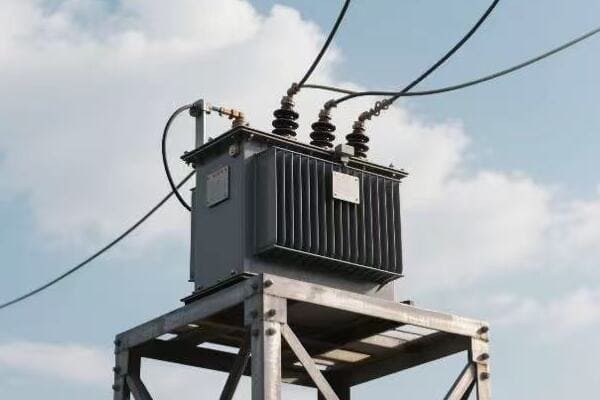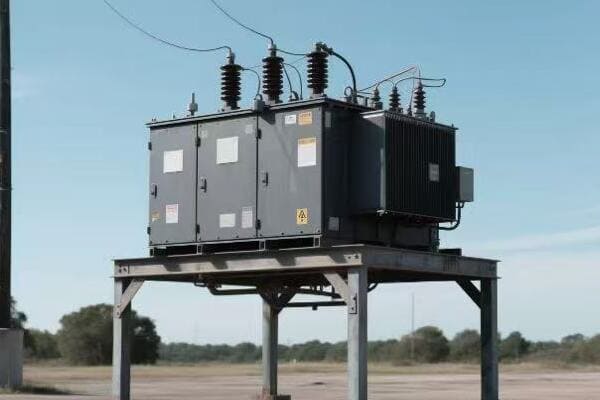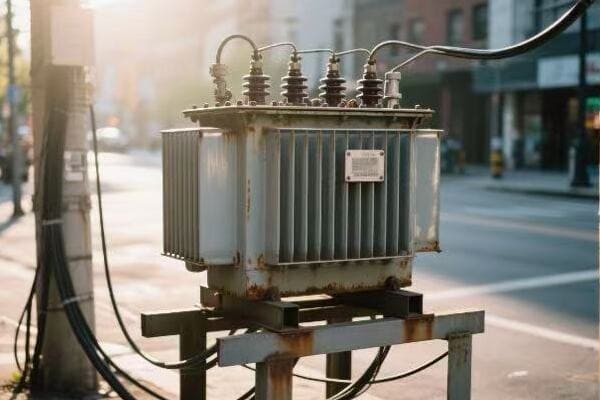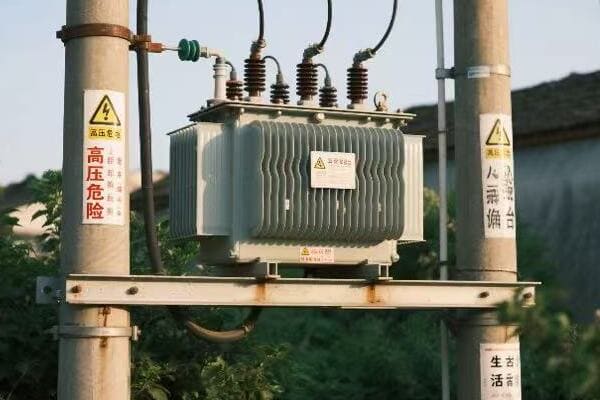Pad Mounted Transformers Explained: What They Are and Why They Matter in Modern Grids?
Are you puzzled by those green boxes you see in your neighborhood? You’re not alone. These mysterious units play a crucial role in powering our homes and businesses, yet many people don’t know what they are.
Pad mounted transformers are ground-level electrical distribution devices that convert high voltage electricity to lower, usable voltages. They are essential in modern power grids, providing safe, efficient, and aesthetically pleasing power distribution in urban and suburban areas.

As an electrical engineer with years of experience in power distribution, I’ve seen firsthand how pad mounted transformers have revolutionized our energy landscape. In this article, I’ll break down what these transformers are, how they work, and why they’re so important in our modern world.
Structure and Function: Understanding the Anatomy of Pad Mounted Transformers?
Have you ever wondered what’s inside those green boxes? The structure of pad mounted transformers is fascinating, and understanding it is key to appreciating their role in our power grid.
Pad mounted transformers consist of a transformer core and windings enclosed in a tamper-resistant, weatherproof cabinet. They typically include high and low voltage compartments, bushings for connections, and safety features like fuses and switches.

Let me take you on a tour of a pad mounted transformer’s anatomy. It’s a bit like peeling an onion, with each layer serving a crucial purpose.
External Cabinet: The First Line of Defense
The outer shell of a pad mounted transformer is more than just a box:
- Material: Usually made of steel or stainless steel
- Design: Tamper-resistant and weatherproof
- Access: Lockable doors for authorized personnel only
- Color: Often green to blend with surroundings
I once worked on a project where we had to custom-design cabinets to match the aesthetic of a historic district. It’s amazing how versatile these units can be!
Internal Components: Where the Magic Happens
Inside the cabinet, you’ll find the heart of the transformer:
Transformer Core and Windings
- Core: Made of laminated steel sheets
- Primary Winding: Connects to high voltage input
- Secondary Winding: Provides lower voltage output
Insulation and Cooling
- Oil-filled designs: Use mineral oil for insulation and cooling
- Dry-type designs: Use air or other gases for cooling
Safety and Control Features
- Fuses: Protect against overcurrents
- Switches: Allow for isolation and maintenance
- Bushings: Insulated points where wires enter/exit the transformer
Compartmentalization: Safety by Design
One of the key features of pad mounted transformers is their compartmentalized design:
| Compartment | Purpose | Access |
|---|---|---|
| High Voltage | Houses primary connections | Limited access |
| Low Voltage | Contains secondary bushings | More accessible |
| Transformer | Houses core and windings | Restricted access |
This design ensures that maintenance can be performed safely on the low voltage side without exposure to high voltage components.
Real-World Application
I remember a project where we installed pad mounted transformers in a new residential development. The homeowners were initially concerned about having "electrical equipment" near their homes. But once we explained the safety features and showed them how discreet the units were, their worries disappeared.
Key Considerations in Design
When designing pad mounted transformers, we focus on:
- Safety: Ensuring public safety is paramount
- Efficiency: Minimizing energy losses
- Reliability: Designing for long-term operation
- Maintainability: Allowing for easy servicing
- Aesthetics: Blending with the environment
Remember, while pad mounted transformers may look simple from the outside, they’re marvels of engineering on the inside. They’re designed to be safe, efficient, and unobtrusive, quietly powering our modern world.
Pad Mounted vs. Traditional Transformers: Key Differences and Applications?
Ever wondered why some neighborhoods have those big transformers on poles while others have ground-level green boxes? The choice between pad mounted and traditional pole-mounted transformers isn’t random. It’s a decision that impacts safety, aesthetics, and functionality.
Pad mounted transformers offer improved safety, better aesthetics, and easier maintenance compared to pole-mounted transformers. They’re ideal for underground distribution systems in urban and suburban areas, while pole-mounted transformers are more common in rural or older urban settings.

As someone who’s worked with both types of transformers, I can tell you that each has its place in our power distribution system. Let’s break down the key differences:
Design and Installation
Pad Mounted Transformers
- Ground-level installation
- Enclosed in a protective cabinet
- Part of underground distribution systems
Pole Mounted Transformers
- Elevated on utility poles
- Open to the elements
- Part of overhead distribution systems
I once had a project where we converted an old neighborhood from overhead to underground distribution. The residents were amazed at how much cleaner their streets looked without the tangle of overhead wires.
Safety Considerations
Safety is always our top priority in electrical engineering. Here’s how the two types compare:
| Aspect | Pad Mounted | Pole Mounted |
|---|---|---|
| Public Access | Limited by locked enclosure | Elevated, but exposed |
| Wildlife Protection | Better protected from animals | More vulnerable to wildlife |
| Storm Resistance | Less affected by high winds | Can be damaged in severe storms |
In my experience, pad mounted transformers have significantly reduced incidents of wildlife-related outages in urban areas.
Aesthetic Impact
- Pad Mounted: Low profile, can be concealed with landscaping
- Pole Mounted: More visible, can be considered unsightly in some areas
Maintenance and Accessibility
Pad Mounted Transformers
- Easy ground-level access for maintenance
- Can be serviced in all weather conditions
- Compartmentalized design for safer maintenance
Pole Mounted Transformers
- Require bucket trucks or climbing for maintenance
- More challenging to service in bad weather
- All components are in one open area
I remember a stormy night when we had to repair a pole mounted transformer. It was a challenging and potentially dangerous operation. Pad mounted transformers make these situations much safer and easier to manage.
Applications and Suitability
Pad Mounted Transformers are ideal for:
- New residential developments
- Urban and suburban areas
- Areas with underground utilities
- Places prioritizing aesthetics (e.g., historic districts)
Pole Mounted Transformers are better suited for:
- Rural areas with overhead lines
- Older urban areas with existing overhead infrastructure
- Areas prone to flooding
Cost Considerations
Initial installation costs can vary:
- Pad Mounted: Higher upfront cost due to underground work
- Pole Mounted: Lower initial cost, but potentially higher long-term maintenance costs
In a recent project, we found that while pad mounted transformers were more expensive to install, they offered significant savings in maintenance and repair costs over a 20-year period.
Environmental Factors
- Pad Mounted: Better protected from environmental factors, longer lifespan
- Pole Mounted: More exposed to weather, potentially shorter lifespan
Future Trends
I’m seeing a growing trend towards pad mounted transformers, especially in urban renewal projects and smart city initiatives. They offer better integration with modern grid technologies and smart metering systems.
Remember, the choice between pad mounted and pole mounted transformers isn’t just about aesthetics or cost. It’s about choosing the right solution for the specific needs of each community and power distribution system. As our cities grow and evolve, I expect we’ll see even more innovative applications of pad mounted transformers in the future.
Urban Grid Solutions: How Pad Mounted Transformers Revolutionize City Power Distribution?
Have you ever wondered how modern cities manage to deliver power so efficiently without a maze of overhead wires? The secret lies in pad mounted transformers, which have quietly revolutionized urban power distribution.
Pad mounted transformers enable underground power distribution, crucial for modern urban planning. They enhance reliability, improve aesthetics, increase safety, and support higher power densities needed in cities, all while reducing maintenance costs and environmental impact.

As someone who’s been involved in numerous urban power projects, I can tell you that pad mounted transformers have been game-changers. Let me show you how they’re reshaping our cities.
Underground Distribution: The Foundation of Modern Urban Power
Pad mounted transformers are the cornerstone of underground distribution systems. Here’s why this matters:
- Aesthetics: Clean, wire-free cityscapes
- Reliability: Less exposure to weather and accidents
- Safety: Reduced risk of electrocution from fallen lines
- Property Values: Improved neighborhood appearance
I once worked on a project to convert an old downtown area to underground distribution. The transformation was stunning – not just in terms of reliability, but in how it changed the entire feel of the neighborhood.
Space Efficiency: Powering Dense Urban Environments
In cities, space is at a premium. Pad mounted transformers offer significant advantages:
| Aspect | Pad Mounted Advantage |
|---|---|
| Footprint | Smaller ground-level footprint compared to substation space |
| Scalability | Easy to add capacity in growing areas |
| Flexibility | Can be installed in various locations (e.g., sidewalks, buildings) |
Smart City Integration: Enabling Modern Urban Technologies
Pad mounted transformers are not just about power – they’re a key part of smart city infrastructure:
- Smart Metering: Easy integration with advanced metering systems
- Grid Automation: Support for remote monitoring and control
- Electric Vehicle Charging: Power supply for urban EV charging stations
- Renewable Energy: Better integration of distributed energy resources
In a recent smart city project, we used pad mounted transformers as nodes in a city-wide energy management system. It allowed for real-time load balancing and predictive maintenance, significantly improving overall grid efficiency.
Urban Resilience: Improving Power Reliability
Cities face unique challenges in maintaining power reliability. Pad mounted transformers help in several ways:
- Weather Resistance: Less vulnerable to storms and high winds
- Flood Mitigation: Can be designed with flood-resistant features
- Fault Isolation: Easier to isolate and repair faults without widespread outages
Environmental Benefits
Pad mounted transformers contribute to greener cities:
- Reduced Visual Pollution: No overhead lines
- Wildlife Protection: Less risk to birds and other wildlife
- Lower EMF Exposure: Shielded design reduces electromagnetic fields
- Oil Containment: Better containment of transformer oil in case of leaks
Case Study: Urban Renewal Project
I was part of a team that worked on revitalizing an old industrial area into a mixed-use development. Here’s what we achieved with pad mounted transformers:
- 30% increase in power capacity without visible infrastructure changes
- 50% reduction in power outages over 5 years
- Integration of rooftop solar on new buildings
- Installation of EV charging stations throughout the area
The project not only improved power distribution but also played a key role in the area’s economic revival.
Challenges and Solutions
While pad mounted transformers offer many advantages, they come with challenges:
-
Initial Cost: Higher upfront investment
Solution: Long-term cost-benefit analysis showing reduced maintenance and outage costs -
Underground Work: More complex installation
Solution: Careful planning and coordination with other utilities -
Flooding Concerns: Risk in flood-prone areas
Solution: Elevated designs and water-resistant enclosures -
Heat Dissipation: Challenges in some urban environments
Solution: Advanced cooling systems and strategic placement
Future Trends in Urban Power Distribution
Looking ahead, I see several exciting developments:
- Integration with Energy Storage: Combining transformers with battery systems for load balancing
- AI-Driven Grid Management: Using artificial intelligence for predictive maintenance and load forecasting
- Modular and Scalable Designs: Allowing for easier capacity upgrades in growing urban areas
Remember, as our cities grow and evolve, so too must our power distribution systems. Pad mounted transformers are not just a current solution; they’re a foundation for the smart, efficient, and beautiful cities of the future.
Smart Grid Integration: The Role of Pad Mounted Transformers in Modern Energy Systems?
Ever wondered how our power grids are getting smarter? Pad mounted transformers are playing a crucial role in this transformation. But how exactly do these unassuming green boxes fit into the complex world of smart grids?
Pad mounted transformers are evolving into intelligent nodes in smart grids. They now incorporate sensors, communication technologies, and automation features, enabling real-time monitoring, efficient power distribution, and integration of renewable energy sources.

As someone who’s been at the forefront of smart grid development, I can tell you that pad mounted transformers are no longer just passive power conversion devices. They’re becoming the eyes, ears, and brains of our modern energy systems. Let me break it down for you.
The Evolution of Pad Mounted Transformers in Smart Grids
Traditional transformers are being upgraded with smart features:
- Sensors: For real-time monitoring of voltage, current, temperature, and oil condition
- Communication Modules: Enabling data transmission to control centers
- Smart Switches: Allowing remote operation and automated responses
- Data Analytics: On-board processing for predictive maintenance and efficiency optimization
I remember when we first started adding these features to transformers. The amount of actionable data we suddenly had access to was mind-blowing!
Key Smart Grid Functionalities Enabled by Pad Mounted Transformers
| Functionality | Description | Impact |
|---|---|---|
| Real-Time Monitoring | Continuous tracking of transformer performance | Improved reliability, faster fault detection |
| Load Balancing | Dynamic adjustment of power distribution | Enhanced efficiency, reduced energy losses |
| Fault Detection and Isolation | Rapid identification and isolation of grid issues | Minimized outage durations and affected areas |
| Voltage Regulation | Automated voltage adjustments | Improved power quality, support for distributed generation |
| Asset Management | Predictive maintenance based on real-time data | Extended equipment life, reduced maintenance costs |
Integration with Renewable Energy Sources
Smart pad mounted transformers are crucial for integrating renewables:
- Bi-Directional Power Flow: Managing power from solar panels and wind turbines
- Voltage Fluctuation Management: Stabilizing grid voltage with variable renewable inputs
- Energy Storage Integration: Coordinating with battery systems for load balancing
In a recent project, we used smart pad mounted transformers to integrate a large solar farm into an existing grid. The transformers’ ability to manage bi-directional power flow and voltage fluctuations was key to the project’s success.
Enhancing Grid Resilience and Self-Healing Capabilities
Smart pad mounted transformers contribute to a more resilient grid:
- Automated Fault Recovery: Quickly rerouting power around damaged sections
- Adaptive Protection: Adjusting protective settings based on grid conditions
- Islanding Detection: Safely managing distributed generation during outages
Data-Driven Decision Making
The wealth of data from smart transformers enables:
- Predictive Maintenance: Anticipating failures before they occur
- Load Forecasting: More accurate predictions of energy demand
- Asset Optimization: Better planning for upgrades and replacements
I once worked on a project where data from smart transformers helped us identify and prevent a potential widespread outage. We were able to replace a failing unit before it caused any disruption.
Challenges in Smart Grid Integration
Integrating pad mounted transformers into smart grids isn’t without challenges:
-
Cybersecurity: Protecting against potential cyber attacks
Solution: Implementing robust encryption and security protocols -
Data Management: Handling the vast amount of data generated
Solution: Advanced data analytics and cloud computing solutions -
Interoperability: Ensuring compatibility with various systems
Solution: Adhering to common standards like IEC 61850 -
Cost: Higher initial investment for smart features
Solution: Demonstrating long-term ROI through improved efficiency and reliability
Future Trends in Smart Transformer Technology
Looking ahead, I see some exciting developments:
- AI and Machine Learning: For more sophisticated grid management and predictive analytics
- Edge Computing: Enabling faster, localized decision-making
- Energy Storage Integration: Combining transformers with battery systems for enhanced grid stability
- EV Charging Infrastructure: Smart transformers managing the load from increased electric vehicle adoption
Real-World Impact: A Case Study
In a recent city-wide smart grid upgrade, we implemented smart pad mounted transformers with the following results:
- 15% reduction in overall energy losses
- 30% faster response time to outages
- 25% increase in renewable energy integration capacity
- 40% reduction in maintenance costs over 5 years
This project showcased how smart pad mounted transformers can significantly improve grid performance and sustainability.
Best Practices for Smart Grid Integration
Based on my experience, here are some key considerations:
- Phased Implementation: Start with pilot projects and scale up
- Comprehensive Training: Ensure utility personnel are well-versed in new technologies
- Stakeholder Engagement: Involve all parties, from regulators to end-users
- Future-Proofing: Design systems with flexibility for future upgrades
- Holistic Approach: Consider the entire grid ecosystem, not just individual components
Remember, the integration of pad mounted transformers into smart grids is not just about technology – it’s about creating a more efficient, reliable, and sustainable energy future. As we continue to innovate, these unassuming green boxes will play an increasingly crucial role in powering our world.
Safety and Efficiency: Exploring the Design Features and Maintenance of Pad Mounted Transformers?
Are you concerned about the safety of those green boxes in your neighborhood? Or perhaps you’re wondering how efficient they really are? These are common questions, and as an expert in the field, I’m here to address them.
Pad mounted transformers are designed with multiple safety features including tamper-resistant enclosures, internal barriers, and advanced protection systems. They also boast high efficiency ratings, typically above 98%, and require regular maintenance to ensure optimal performance and longevity.

Safety and efficiency are paramount in the design and maintenance of pad mounted transformers. Let me take you through the key aspects that make these units both safe for the public and efficient in their operation.
Safety Features: Protecting the Public and Utility Workers
Pad mounted transformers incorporate several safety measures:
-
Tamper-Resistant Enclosures
- Locked cabinets with specialized opening mechanisms
- Robust materials resistant to forced entry
-
Internal Compartmentalization
- Separate high and low voltage sections
- Barriers to prevent accidental contact with live parts
-
Grounding and Bonding
- Proper grounding to prevent electrocution risks
- Equipotential bonding to minimize step and touch potentials
-
Protective Devices
- Fuses and circuit breakers for overcurrent protection
- Pressure relief devices to prevent explosions
I once worked on a project where we had to design transformers for a school zone. We added extra safety features like double-locking mechanisms and impact-resistant enclosures to ensure maximum protection.
Efficiency Considerations: Minimizing Losses and Maximizing Performance
Modern pad mounted transformers are highly efficient:
| Aspect | Details |
|---|---|
| Core Losses | Minimized through advanced core materials like amorphous metals |
| Winding Losses | Reduced with optimized winding designs and materials |
| Cooling Systems | Efficient oil or dry-type cooling to manage heat |
| Load Management | Smart features for optimal load distribution |
In a recent upgrade project, we replaced old transformers with new, high-efficiency models. The result was a 2% increase in overall efficiency, which translated to significant energy savings for the utility.
Maintenance Practices: Ensuring Long-Term Performance and Safety
Regular maintenance is crucial for pad mounted transformers:
-
Routine Inspections
- Visual checks for signs of damage or tampering
- Thermal imaging to detect hotspots
-
Oil Testing and Filtration (for oil-filled units)
- Regular oil sampling and analysis
- Filtration or replacement of degraded oil
-
Electrical Testing
- Insulation resistance tests
- Turn ratio tests to ensure proper voltage transformation
-
Cleaning and Pest Control
- Removal of debris and vegetation
- Measures to prevent animal intrusion
-
Component Replacement
- Replacement of worn gaskets and seals
- Updating of outdated protection devices
I remember a case where regular oil testing helped us identify a developing fault before it caused a failure. Preventive maintenance like this can save utilities millions in potential outage costs.
Balancing Safety and Accessibility
Designing for both safety and maintainability is a delicate balance:
- Safety Locks: Must be secure yet allow quick access for emergency repairs
- Internal Layout: Organized for safety but with consideration for ease of maintenance
- Labeling and Documentation: Clear, durable labels and easily accessible documentation
Environmental Considerations
Modern pad mounted transformers are designed with the environment in mind:
- Oil Containment: Secondary containment systems to prevent soil contamination
- Noise Reduction: Design features to minimize operational noise
- Eco-Friendly Materials: Use of biodegradable oils and recyclable components
Smart Features Enhancing Safety and Efficiency
The integration of smart technologies is improving both safety and efficiency:
- Remote Monitoring: Allows for real-time tracking of transformer health
- Predictive Maintenance: AI-driven systems to forecast potential issues
- Automated Controls: Smart switching for optimal load management
Challenges and Solutions in Maintenance
-
Challenge: Aging Infrastructure
Solution: Phased replacement programs and retrofitting with modern components -
Challenge: Skilled Labor Shortage
Solution: Training programs and adoption of user-friendly diagnostic tools -
Challenge: Increasing Power Demands
Solution: Regular capacity assessments and strategic upgrades
Best Practices for Transformer Management
Based on my experience, here are some key recommendations:
- Implement a Comprehensive Maintenance Schedule
- Invest in Training for Maintenance Personnel
- Utilize Data Analytics for Predictive Maintenance
- Keep Detailed Records of All Maintenance Activities
- Stay Updated on Latest Safety Standards and Technologies
Future Trends in Transformer Safety and Efficiency
Looking ahead, I see several exciting developments:
- Self-Healing Materials: Transformers that can repair minor damages autonomously
- Advanced Sensors: More sophisticated monitoring capabilities
- Green Insulation: Development of even more environmentally friendly insulating materials
- AI-Driven Maintenance: Fully automated diagnostic and maintenance scheduling systems
Remember, while pad mounted transformers are designed to be safe and efficient, proper maintenance and management are crucial. By following best practices and staying informed about new technologies, we can ensure these vital components of our power grid continue to operate safely and efficiently for years to come.
Conclusion
Pad mounted transformers are crucial components in modern power grids, offering safety, efficiency, and smart integration capabilities. Their design, maintenance, and ongoing evolution play a vital role in shaping the future of urban power distribution and smart energy systems.
Free CHBEB Transformer Catalog Download
Get the full range of CHBEB transformers in one catalog.
Includes oil-immersed, dry-type, pad-mounted, and custom solutions.
Quick Message
Request A free quote
We'd like to work with you
- +86 15558785111
- [email protected]
- +86 15558785111
What We Do
CHINA BEI ER BIAN (CHBEB) GROUP, with 218 million in registered capital, originated from Beijing Beierbian Transformer Group. Headquartered in Beijing for R&D, it operates major production bases in Nanjing and Yueqing, producing high-quality products.
Latest Product
address
BeiJing
No 3,RongJing East Road,BeiJing Economic Technological Development Area,BeiJing,China
JiangSu
No 7️Xiangfeng Road,Jiangning,NanJing,JiangSu,China
WenZhou
No.211, Wei 16 Road, Industrial Zone, Yueqing, Wenzhou, Zhejiang, China.
XiangYang Industrial Zone ,YueQing,WenZhou,ZheJiang,China
contact us
- [email protected]
- +86 13057780111
- +86 13057780111
- +86 15558785111
Copyright © Bei Er Bian Group


